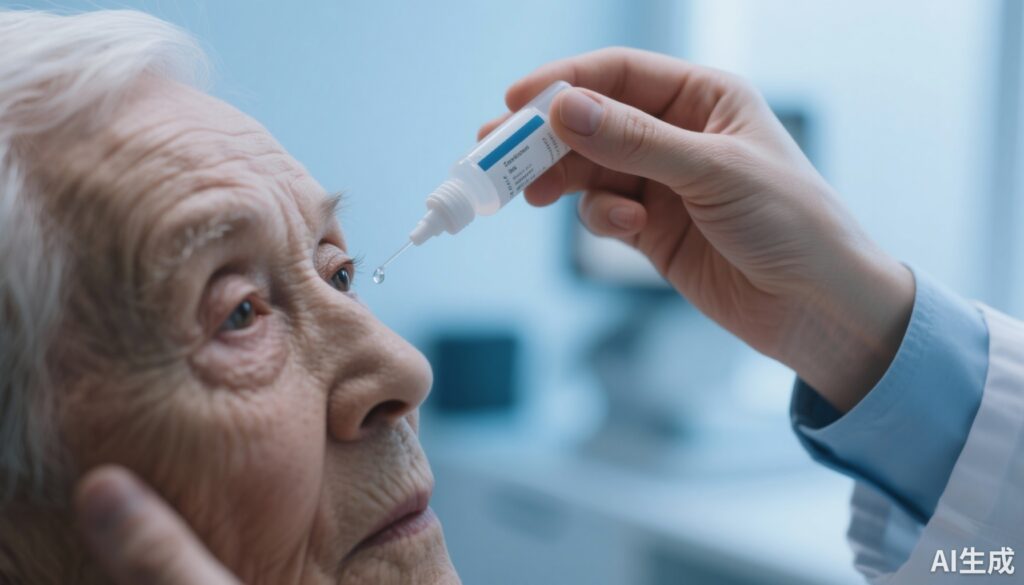Highlight
– In a prospective, phase IV open‑label study in China, topical cenegermin produced corneal healing in 22/26 (84.6%, 95% CI 65.1–95.6%) patients with stage 2–3 neurotrophic keratopathy (NK) at 8 weeks.
– Treatment effects were durable through 56 weeks for most patients: 20/22 (90.9%) patients who achieved initial healing remained healed at week 56, while three experienced recurrence during follow‑up.
– Cenegermin was generally well tolerated; most treatment‑emergent adverse events (TEAEs) were mild to moderate and treatment‑related events were uncommon and transient (most commonly eye pain).
Background: disease burden and unmet need
Neurotrophic keratopathy (NK) is a rare, potentially sight‑threatening corneal disease resulting from impaired trigeminal corneal innervation. Loss of corneal sensation disrupts epithelial homeostasis and wound healing, increasing the risk of persistent epithelial defects, sterile ulceration, stromal melt and perforation. Clinical staging (Mackie classification) grades NK from stage 1 (epithelial irregularities) to stage 3 (corneal ulceration with stromal involvement). Management is challenging because many conventional ocular surface therapies (lubrication, bandage contact lenses, tarsorrhaphy) treat symptoms or mechanical complications rather than the underlying nerve deficit.
Recombinant human nerve growth factor (rhNGF, cenegermin) is a biologic therapy designed to address the pathophysiology of NK by promoting corneal nerve survival, regeneration and epithelial healing. Cenegermin (20 µg/mL ophthalmic solution, commercial name Oxervate in some regions) received regulatory approval in multiple jurisdictions for treatment of stage 2–3 NK after randomized controlled trials demonstrated increased corneal healing versus vehicle in predominantly Western patient populations. Data from other geographic and ethnic populations have been limited, motivating post‑marketing studies to evaluate effectiveness, safety and pharmacokinetics in routine clinical settings.
Study design
The study by Li et al. (CTR20220066) is a prospective, phase IV, open‑label, multicenter trial conducted in China to assess the efficacy, safety and pharmacokinetics (PK) of topical cenegermin in patients with stage 2 or 3 NK in routine clinical practice. Key elements were:
- Population: 28 Chinese patients with moderate or severe NK (stage 2 or 3).
- Intervention: cenegermin ophthalmic solution 20 µg/mL, administered 6 times daily at 2‑hour intervals for 8 weeks.
- Follow‑up: assessments through week 56 to capture durability of healing and recurrence.
- Endpoints: the primary endpoint was corneal healing at week 8 as judged by the investigator. Secondary outcomes included lesion worsening during treatment, healing durability through week 56, safety (treatment‑emergent adverse events, TEAEs) and pharmacokinetic assessments.
As an open‑label, single‑arm phase IV study, the design reflects real‑world practice but lacks a randomized or masked comparator, which is important when interpreting effect sizes and safety signals.
Key findings
Primary efficacy
Of 28 enrolled patients who received cenegermin, 26 had evaluable week‑8 outcomes (two missing). Investigator‑assessed corneal healing at week 8 was achieved in 22/26 patients (84.6%; 95% CI 65.1–95.6%). The reported point estimate aligns favorably with healing rates observed in earlier controlled trials and supports clinical effectiveness in this Chinese cohort.
Durability and recurrence
Among the 22 patients who achieved healing at week 8, three (13.6%) experienced recurrence during the 48‑week follow‑up period; by week 56, 20/22 (90.9%) remained healed. These data indicate that the majority of initial responders maintained long‑term epithelial integrity, although a minority relapsed and required additional management.
Lesion worsening
Two of 28 patients (7.1%) experienced lesion worsening during the 8‑week treatment. The report does not indicate whether these events reflected progression to deeper ulceration, required surgical intervention, or were associated with systemic or ocular comorbidities; detailed case descriptions are provided in the full publication and should be reviewed when considering risk mitigation.
Safety
Safety assessments showed that 25/28 patients (89.3%) experienced at least one TEAE; most events were classified as mild or moderate (23/28, 82.2%). Ten patients (35.7%) reported serious TEAEs, but none were judged by investigators to be related to cenegermin or to have led to treatment discontinuation. The most commonly identified cenegermin‑related TEAE was eye pain (5/28, 17.9%), primarily occurring during the treatment period and largely transient. No unexpected systemic safety signals were highlighted in the summary.
Pharmacokinetics
The study protocol included PK assessments. The study summary provided here does not present detailed PK data; the full article should be consulted for measured systemic exposure and any interpretation of PK findings relative to safety. Previous clinical experience with topical cenegermin has shown minimal systemic exposure, but local tolerability (eg, ocular pain on instillation) is a recurrent observation.
Interpretation and clinical implications
This phase IV Chinese cohort demonstrates that topical cenegermin can achieve high rates of corneal epithelial healing in patients with stage 2–3 NK and that responses are durable for most patients up to 56 weeks. The safety profile observed—predominantly mild to moderate TEAEs and transient treatment‑related ocular discomfort—matches the expected tolerability from prior clinical experience and supports use in a real‑world clinical setting.
For clinicians managing NK in Chinese or similar populations, these data provide reassuring post‑marketing evidence that cenegermin’s efficacy and safety translate beyond the initial trial populations. Importantly, the open‑label, single‑arm design means absolute effect sizes cannot be directly compared with placebo‑controlled trials; however, the consistency of high healing rates and acceptable tolerability across studies supports a role for cenegermin as a disease‑modifying therapy in moderate and severe NK.
Expert commentary: strengths, limitations and context
Strengths of the study include its prospective, multicenter design, extended 56‑week follow‑up capturing recurrence and durability, and focus on an understudied geographic population. Real‑world treatment schedules and routine clinical assessments increase the generalizability of findings to everyday ophthalmic practice.
Key limitations must guide interpretation: the small sample size (n=28) limits precision and subgroup analyses; the open‑label, nonrandomized design introduces potential selection and assessment biases; and two missing week‑8 evaluations reduce the evaluable denominator. Detailed PK data were not summarized here, and some safety events were serious albeit judged unrelated to study drug—full case narratives are important for clinicians assessing risk in complex patients.
Mechanistically, cenegermin targets corneal nerves with biologic plausibility for improving epithelial integrity and reducing recurrence risk by restoring trophic support. Emerging adjunctive strategies (eg, autologous serum tears, amniotic membrane transplantation, tarsorrhaphy) remain important options for severe or nonresponsive cases; cenegermin may be integrated into multimodal care as a frontline biologic therapy for stage 2–3 NK.
Practical considerations for clinicians
Patient selection: cenegermin is indicated for stage 2–3 NK when epithelial defects or ulcers are present. Assess and document corneal sensitivity, ulcer characteristics, and underlying etiologies (eg, herpetic disease, diabetes, cranial nerve injury) as these factors influence prognosis and adjunctive management.
Administration and adherence: treatment requires frequent instillation (six times daily) for 8 weeks, which can challenge adherence. Educating patients and caregivers on dosing schedules and temporary ocular discomfort (eg, eye pain) is essential.
Monitoring: regular slit‑lamp examinations during and after treatment are necessary to confirm epithelial closure, detect recurrence, and identify complications (progression to stromal involvement or infection).
Conclusion
The multicenter, phase IV open‑label study conducted in China adds important post‑marketing evidence supporting cenegermin as an effective and generally well‑tolerated therapy for stage 2–3 neurotrophic keratopathy in this population. High rates of investigator‑assessed corneal healing at 8 weeks and durable responses through 56 weeks were achieved in the majority of treated patients. Limitations related to small sample size and lack of randomized comparator require cautious interpretation, but results align with prior clinical experience and support cenegermin’s role as a disease‑modifying option for NK.
Funding and trial registration
See the original publication for detailed funding disclosures. Trial registration: CTR20220066.
References
1. Li S, Xu J, Yuan J, Pan Z, Siri G, Hauswirth SG, Mantelli F, Shi W. Cenegermin for the Treatment of Moderate or Severe Neurotrophic Keratopathy: Results from a Prospective, Phase IV, Open‑Label Study in China. Ophthalmol Ther. 2025 Dec;14(12):3021-3033. doi: 10.1007/s40123-025-01253-5. PMID: 41046317; PMCID: PMC12579034.
2. Sacchetti M, Lambiase A. Diagnosis and management of neurotrophic keratitis. Clin Ophthalmol. 2014;8:571–579. (Review of pathogenesis and therapeutic approaches.)
3. US Food and Drug Administration. Oxervate (cenegermin‑bkbj) ophthalmic solution prescribing information. 2018. (Approval and product labeling for topical cenegermin.)
Readers are encouraged to consult the full manuscript by Li et al. for supplementary tables, PK details and individual case descriptions that further inform risk‑benefit decisions.



